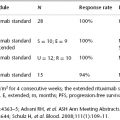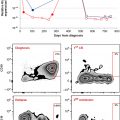Anal Cancer
Mount Vernon Cancer Centre, Northwood, UK
Introduction
Squamous cell cancer of the anus (SCCA) is a rare disease that makes up approximately 2% of all cancers in the lower alimentary tract. The incidence is increasing, with 5820 new cases registered in the United States in 2011. Squamous cell carcinoma (SCC) is commonly associated with human papilloma virus (HPV) infection (usually HPV16 or HPV18). Other risk factors include cigarette smoking, a history of receptive anal intercourse, a history of other HPV-related cancers, human immunodeficiency virus (HIV) infection, and immunosuppression after solid organ transplantation.
SCCA usually presents as and remains a loco-regional disease. The majority of patients have symptoms for long periods of time before diagnosis. Nonsurgical treatment with chemoradiation (CRT) is highly effective. Few develop distant metastases unless there is recurrence at the primary site. Hence, local control without the recourse to a colostomy and enjoyment of an optimal quality of life are the primary aims of treatment.
Three phase III trials showed that radiotherapy (RT) with concurrent 5-fluorouracil (5FU) and mitomycin (MMC) achieves better outcomes in terms of local control and recurrence- or disease-free survival (RFS and DFS, respectively) compared to RT alone, or RT combined with 5FU alone. Phase III trials by the Radiotherapy Therapy Oncology Group RTOG 98-11 and the Action Clinique Coordonees en Cancerologie Digestive ACCORD-03 phase III trial failed to show benefit for the addition of cisplatin-based neoadjuvant chemotherapy (NACT) prior to CRT in terms of colostomy-free survival (CFS). In the RTOG 9811 trial, the cisplatin arm confers a worse DFS and a higher colostomy rate. The ACCORD-03 trial also failed to show a benefit in CFS from an increase in the radiotherapy boost dose. Preliminary results of the United Kingdom National Anal Cancer Trial (ACT II) confirm the standard of 5FU and MMC CRT. Results show 3-year RFS rates overall of 73% (75% in T1/T2 tumors, and 68% for more advanced T3/T4 tumors). The dose and treatment schedule used in the ACT II trial are now the current standard of care in the United Kingdom.
However, the rarity and the different behavior and natural history (depending on whether SCCA originates predominantly at the anal margin, at the anal canal, or above the dentate line) provide limited experience for any individual oncologist.
There have been some recent developments in our understanding of the molecular biology and processes that lead to anal cancer. There have also been some notable successes in prevention, imaging, and treatment. Hence the author hopes to provide some information from the randomized and retrospective trials that can assist the medical and radiation oncologist in the practical management of this unusual cancer.
1. Should everyone with anal cancer, especially the young, be tested for HPV/p16?
Exposure to HPV infection is common, occurring in a significant proportion of the overall population who are sexually active and have not been vaccinated. HPV infection is closely correlated with SCCA. The presence of the HPV genome has been identified in 80–85% of cases, and it is similar to that seen in cervical and vulval carcinoma in women. HPV16 is the commonest high-risk HPV genotype found in anal cancer. In HPV-positive human cancers, two viral oncoproteins, E6 and E7 (which target cellular tumor suppressors), are preferentially expressed via integration of the viral genome into the host DNA. E6 binds to p53, leading to deregulation of DNA damage and apoptotic pathways. E7 targets pRb for degradation, leading to an increase in cell proliferation and genomic instability.
As in oropharyngeal cancer, HPV16-positive anal cancer patients appear to have better outcomes than other subtypes, although most of the evidence has been derived from small retrospective studies. The cell cycle regulator p16 is overexpressed in high-risk-HPV-related cervical cancers, which may represent a simple surrogate biomarker for identifying SCCs harboring HPV DNA. A recent UK study examined samples from 153 patients with anal cancer for p16 with immunohistochemistry, and found 37/137 patients (27%) with moderate or strong p16 staining subsequently relapsed. In contrast, 10 out of 16 (63%) patients with absent or weak staining relapsed.
2. Do HPV vaccines improve outcomes in invasive SCCA?
Safe and effective vaccines (HPV2 and HPV4) are commercially available for the prevention of HPV16 and HPV18 infection. Recent evidence suggests that the efficacy of these vaccines against oncogenic HPV is more than 90% for anal intraepithelial neoplasia. However, prophylactic vaccines do not prevent anal cancers in patients already infected with high-risk HPVs, or in individuals who already have anal cancer. Hence HPV vaccines will not improve outcomes at this stage. In these groups, novel therapeutic vaccines to target the HPV oncogenes or the cellular pathways they affect rather than HPV are under investigation. These vaccines potentially could improve clinical outcome for patients with anal cancer, as with other HPV-associated cancers.
3. Should cancers of the anal margin, anal canal, and rectum be treated differently or the same?
The definitions of the anal canal and anal margin used by the National Comprehensive Cancer Network (NCCN) separate the anal canal from the rectum with the landmark of the upper border of the anal sphincter and puborectalis muscles. The anal canal extends 3–5 cm in length to the anal verge. The anal margin includes the perianal skin over a 5 cm radius from the anal verge. In practice, at diagnosis most anal carcinomas have extended such that their point of origin is uncertain, and the distinction between anal canal and anal margin tumor is therefore often impossible. Local excision of anal margin cancers is possible for small lesions (usually <1 cm) allowing 1 cm surgical clearance, but it should be performed by specialist surgeons (see Question 7, this chapter).
4. Are there any biomarkers?
For more advanced stages of anal cancer, there remains considerable heterogeneity in terms of outcomes. Biomarkers that affect these outcomes would be useful to provide predictive and prognostic information and, in turn, inform individualized therapies. However, most studies have focused on the identification of factors that predict cytotoxic drug response and/or radiosensitivity. These studies have invariably analyzed only a limited number of markers in small numbers of patients, with a variety of treatment regimes, and their results can be considered preliminary. So further refinement is needed in this field.
A recent systematic review examined 29 different biomarkers belonging to nine different functional classes: tumor suppressors, epidermal growth factor receptor (EGFR), apoptosis regulation, proliferation index, angiogenesis, tumor-specific markers (e.g., SCCAg and CEA), Hedgehog signaling, and telomerase. Tumor suppressor genes p53 and p21 were the only biomarkers that were prognostic in more than one study. In anal cancer, p53 protein function may be modified either by mutations in its gene or by E6 viral oncoprotein of the HPV virus. In an analysis of 240 patients randomized in the UKCCR ACT I anal cancer trial, the presence of mutated p53 predicted for a poorer cause-specific survival. Recent data regarding p16 and serum SCC antigen are promising, but in summary, there are no current biomarkers that consistently predict sensitivity to chemoradiation.
5. What is the role for sentinel lymph node biopsy (SLNB) in staging anal cancers?
SNLB is validated in lymph node (LN) staging of small breast tumors with the aim of avoiding a formal axillary dissection. In anal cancer, the rationale for SLNB is to spare the patient formal inguinal irradiation and to avoid the skin morbidity associated and the potential for high-radiation doses to the femoral heads. An early systematic review of five published series (only 83 patients) evaluated the outcome of SLNB of non-enlarged inguinal nodes in patients with anal cancer. Only 21% of sentinel nodes contained tumor.
Because the initial treatment has been nonsurgical for the past 25 years, we don’t know the true LN status of anal cancer. Currently, in the patient with clinically impalpable nodes, we rely on computed tomography (CT) and magnetic resonance imaging (MRI) in T1/T2, where the risks of LN involvement are low. Conventionally, routine biopsy is only performed for clinically palpable nodes or those enlarged greater than 10 mm on CT or MRI.
SLNB has not achieved its initial potential in anal cancer, partly because MRI and positron emission tomography (PET) are increasingly in the routine diagnostic work-up. Also acute morbidity is less with more conformal radiation therapy (RT) techniques (e.g., intensity-modulated RT (IMRT)) currently being used. Formal biopsy or SLNB can reveal micrometastatic spread of disease compared with the spatial resolution of CT and PET, typically in the range of 5–10 mm, but micrometastatic involvement may not be relevant if the patient is going to receive low-dose inguinal irradiation. Also, there are no validated management strategies to stratify treatment for the findings of macroscopic nodal involvement, microscopic involvement, and the presence of a few isolated cells in the light of SLNB.
There are also concerns that SLNB could prejudice the effectiveness of CRT because radiotherapy may require delay until healing is achieved. In one study of SLNB, 24% of patients had a postoperative complication in the groin. SLNB may also compromise the lymphatic drainage, and it may provoke lymphoedema if subsequent high-dose RT is required following a positive nodal finding on SLNB, compared to the low doses necessary for clinically uninvolved nodes. Current prophylactic doses are relatively low—in the region 30–36 Gy. Isolated inguinal failures in the ACT II study were very low for uninvolved nodes treated to 30.6 Gy, and late morbidity was slight for these patients. In contrast, we do not know the morbidity of irradiating to 50.4 Gy after a positive finding on SLNB, particularly as with some midline cancers some SLNB will require bilateral nodes to be removed.
In summary, SLNB may be more helpful in the setting of loco-regional recurrence after CRT to decide whether a radical inguinal dissection should be performed, when radical surgical salvage is envisaged.
6. After a local excision, what are acceptable surgical margins, whereby chemoradiation does not need to be administered?







